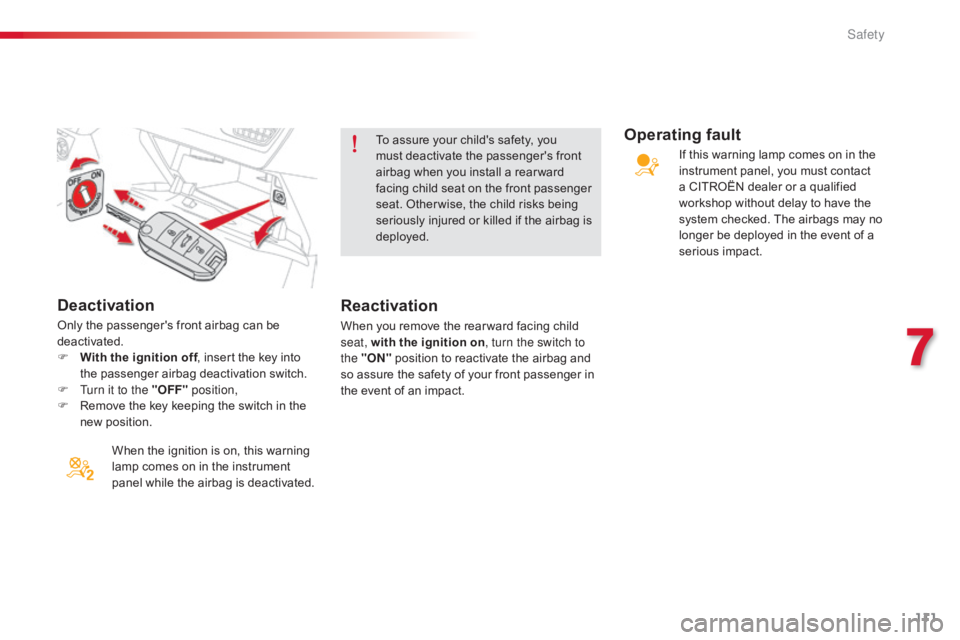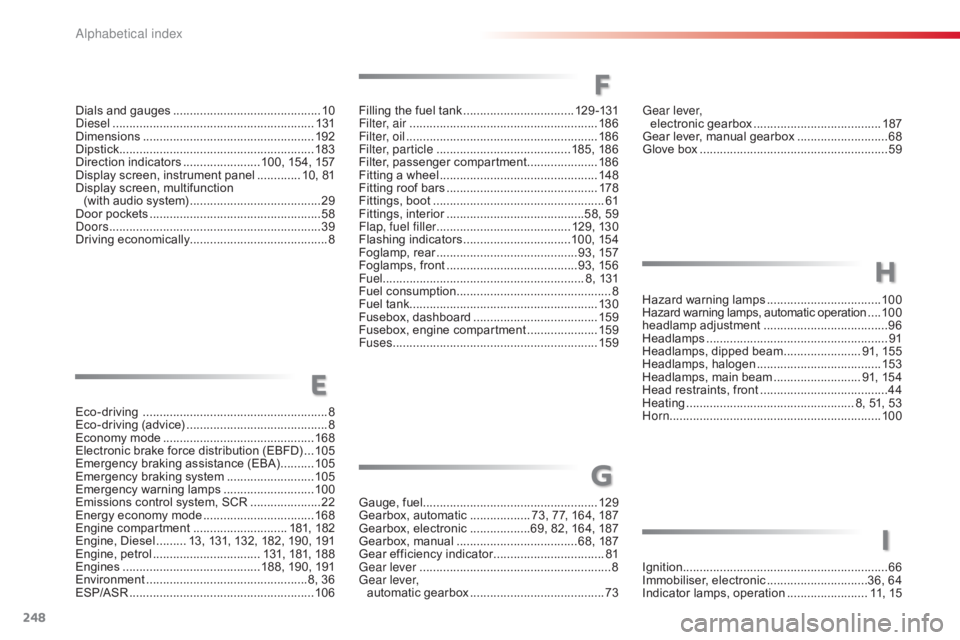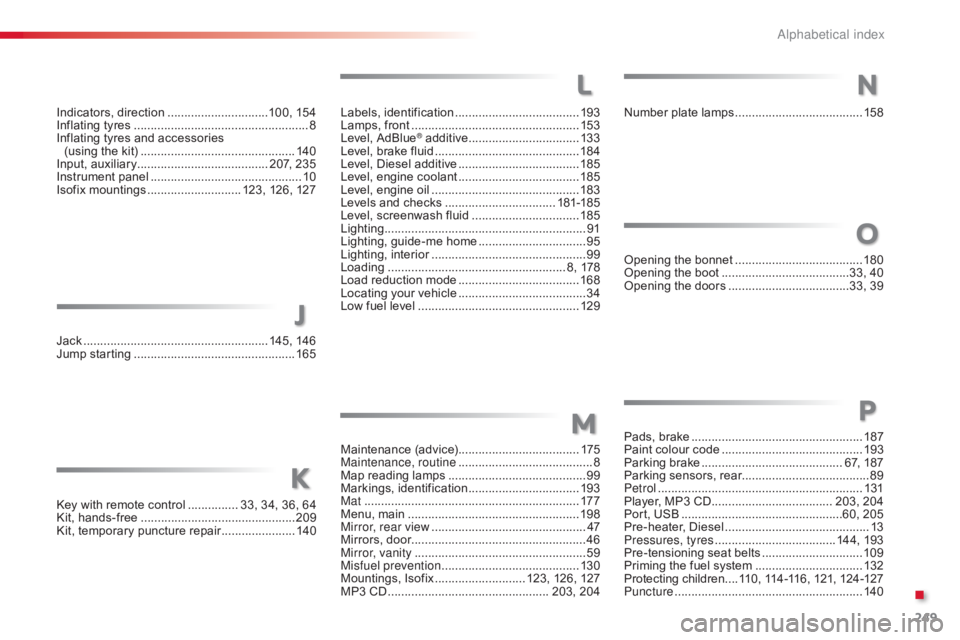instrument panel CITROEN C-ELYSÉE 2016 Owner's Manual
[x] Cancel search | Manufacturer: CITROEN, Model Year: 2016, Model line: C-ELYSÉE, Model: CITROEN C-ELYSÉE 2016Pages: 260, PDF Size: 7.11 MB
Page 108 of 260

106
C-elysee_en_Chap07_securite_ed01-2016
Anti-slip regulation (ASR)
and electronic stability
programme (ESP)
The anti-slip regulation (also known as Traction Control) optimises traction to prevent skidding o
f the wheels, by acting on the brakes of the
d
riving wheels and on the engine.
The
electronic stability programme acts on the
b
rake of one or more wheels and on the engine
t
o keep the vehicle on the trajectory required by
t
he driver, within the limits of the laws of physics.
This
is indicated by flashing of this
w
arning lamp in the instrument panel. The
ASR /ESP systems offer
e
xceptional safety in normal driving, but
t
his should not encourage the driver to
t
ake extra risks or drive at high speed.
The
correct functioning of these
s
ystems depends on observation of
t
he
ma
nufacturer's
r
ecommendations
r
egarding the wheels (tyres and rims),
t
he braking components, the electronic
c
omponents and the assembly
a
nd repair procedures used by the
C
ITROËN dealer network.
After
an impact, have these systems
c
hecked by a CITROËN dealer or a
q
ualified
w
orkshop.
Operating fault
Illumination of the warning lamp, accompanid by a message in the
s
creen indicates a malfunction of
t
hese systems.
Reactivation
These systems are reactivated automatically every time the ignition is switched of, or from
3
0 mph (50 km/h).
F
P
ress this button again to reactivate them
m
anually.
T
he lamp in the button goes off.
The
symbol going off in the instrument panel
i
ndicates the reactivation of the ASR and
ES
P systems.
Deactivation
In exceptional conditions (starting a vehicle which is bogged down, stuck in snow, on soft
g
round, ...), it may be advisable to deactivate
t
he ASR and ESP systems, so that the wheels
c
an move freely and regain grip.
Trajectory control systems
Activation
These systems are activated automatically each time the vehicle is started.
They
come into operation in the event of a grip
o
r
t
rajectory
pro
blem. The
display of this symbol indicates
t
hat the ASR and ESP systems are
d
eactivated.
F
P
ress this button button, located on
t
he dashboard (driver's side), until the
c
orresponding symbol appears in the i
nstrument panel screen. T
he lamp in the button comes on.Contact
a CITROËN dealer or a qualified
w
orkshop to have the ASR /ESP systems
c
hecked.
Coasting with the engine off results in a
l
oss of power assistance for the steering.
S
Page 113 of 260

111
C-elysee_en_Chap07_securite_ed01-2016
Deactivation
When the ignition is on, this warning lamp comes on in the instrument
p
anel while the airbag is deactivated.To
assure your child's safety, you
m
ust deactivate the passenger's front
a
irbag when you install a rear ward
f
acing child seat on the front passenger
s
eat. Other wise, the child risks being
s
eriously injured or killed if the airbag is
d
eployed.
Reactivation
Only the passenger's front airbag can be d
eactivated.
F
W
ith the ignition off ,
insert the key into
t
he passenger airbag deactivation switch.
F
T
urn it to the "OFF" position,
F
R
emove the key keeping the switch in the
n
ew position. When
you remove the rear ward facing child
sea
t, with the ignition on, turn the switch to
the "ON"
position to reactivate the airbag and
s
o assure the safety of your front passenger in
t
he event of an impact.
Operating fault
If this warning lamp comes on in the instrument panel, you must contact
a
CITROËN dealer or a qualified
w
orkshop without delay to have the
s
ystem checked. The airbags may no
l
onger be deployed in the event of a
s
erious
im
pact.
7
Safety
Page 131 of 260

129
C-elysee_en_Chap09_info-pratiques_ed01-2016
Low fuel level
When the low fuel level in the tank is reached, this warning lamp comes
o
n in the instrument panel.
Opening
the filler cap may result in an
i
nrush of air. This vacuum is entirely
n
ormal and results from the sealing of
t
he fuel system.
Fuel tank
Capacity of the tank: approximately 50 litres.A label on the inside of the filler flap reminds
y
ou of the type of fuel to use according to your
e
ngine.
Additions
of fuel must be of at least 5 litres to
b
e registered by the fuel gauge.
Refuelling
F Open the filler cap by turning it a 1/4 turn to t
he left.
F
R
emove the filler cap and hang it on its
c
arrier (on the filler flap).
F
F
ill the tank. Do not continue past the third
c
ut-off of the nozzle, as this may cause
m
alfunctions.
F
R
efit the filler cap turning it a 1/4 turn to
t
he right.
F
P
ush the filler flap to close it.Opening
F Raise the l ever.
When it first comes on, around 5 litres of fuel
remain in the tank.
You must refuel as soon as possible to avoid
r
unning out.
If you run out of fuel (Diesel), refer the the
"
Checks"
s
ection.
9
Practical information
Page 136 of 260

134
C-elysee_en_Chap09_info-pratiques_ed01-2016
Range indicators
Once the AdBlue® tank is on reserve or after d
etection
of
a
fault with the SCR emissions
c
ontrol
system,
when the ignition is switched
o
n,
an
indicator
displays an estimate of the
d
istance
that
can
be covered, the range, before
e
ngine
starting
is
prevented.
In
the
event
of
simultaneous system fault and
l
ow
AdBlue
® level, the shortest range figure is t
he
one
displayed.
In the event of the risk of non-starting related to a lack of AdBlue®
Range greater than 1 500 miles (2 400 km)
When the ignition is switched on, no
i
nformation on range is displayed automatically
i
n the instrument panel.
Remaining range between 350 and 1500 miles (600 and 2 400 km)
When switching on the ignition, the UREA warning lamp comes on, accompanied by an
a
udible signal and the temporary display in
t
he instrument panel of "NO START IN" and
a
distance, indicating the remaining range
e
xpressed in miles or kilometres before
e
ngine starting is prevented - (For example
"
NO START IN 900 miles" means that "Starting
w
ill be prevented in 900 miles).
When
driving, this display appears every
1
50 miles (300 km) until the additive tank has
be
en
t
opped-up.
Go
to a dealer CITROËN or a qualified
w
orkshop to have the AdBlue
® tank topped-up.
Y
ou
can
also
top-up
the
tank
yourself.
For
more
information
on
topping-up the
Ad
Blue
® additive, refer to the corresponding s
ection.
The
engine
start
prevention
system
r
equired
by
regulations
is
activated
a
utomatically
once
the
AdBlue
® tank is e
m pt y.
Practical information
Page 137 of 260

135
C-elysee_en_Chap09_info-pratiques_ed01-2016
Breakdown related to a lack of AdBlue® additive
When switching on the ignition, the SERVICE w
arning lamp comes on and the UREA
w
arning lamp flashes, accompanied by an
a
udible signal and the temporary display in
t
he instrument panel of "NO START IN" and
0 k
m or miles - ("NO START IN 0 miles" means
"
Starting
p
revented").
The
Ad
Blue
® tank is empty: t he s ystem r equired b
y
regulations prevents engine starting.
Remaining range between 0 and 350 miles (0 and 600 km)
When switching on the ignition, the SERVICE warning lamp comes on and the UREA
w
arning lamp flashes, accompanied by an
a
udible signal and the temporary display in
t
he instrument panel of "NO START IN" and
a
distance indicating the remaining range
e
xpressed in miles or kilometres before
e
ngine starting is prevented - (For example
"
NO START IN 180 miles" means "Starting will
b
e prevented in 180 miles).
When
driving, this display appears every
3
0 seconds until the additive tank has been
t
opped-up.
Go
to a CITROËN dealer or a qualified
w
orkshop to have the AdBlue
® tank topped-up.
Y
ou
can
also
top-up
the
tank
yourself.
Other wise you will not be able to restart your
engine.
For
more
information
on
topping-up the
Ad
Blue
® additive, refer to the corresponding s
ection. To
be able to start the engine,
w
e recommend that you call on
a
CITROËN dealer or a qualified
w
orkshop for the top-up required. If
y
ou carry out the top-up yourself, it is
e
ssential to add at least 3.8 litres of
Ad
Blue
® to the additive tank.
F
or
more information on topping-up
t
he
AdBlue
® additive, refer to the c
orresponding s ection.
9
Practical information
Page 150 of 260

148
C-elysee_en_Chap09_info-pratiques_ed01-2016
Removing a wheel
Parking the vehicle
Immobilise the vehicle where it does not block traffic: the ground must be level,
s
table and not slippery.
Apply
the parking brake, switch off the
i
gnition and engage first gear* to block
t
he wheels.
Check
that the parking brake warning
l
amp in the instrument panel comes on.
The
occupants must get out of the
v
ehicle and wait where they are safe.
Ensure
that the jack is correctly
p
ositioned at one of the vehicle's
j
acking points.
Incorrect
use of the jack could cause
t
he vehicle to drop.
Never
go underneath a vehicle raised
u
sing a jack; use an axle stand.
List of operations
Do not use a jack other than the one supplied by the manufacturer.
*
P
osition
R
for
an
electronic
gearbox;
P for an
automatic
gearbox.
Wheel with wheel trim
When removing the wheel , first
remove the wheel trim using the
w
heelbrace 1 by pulling at the valve
a
perture.
When refitting the wheel , refit the
wheel
trim, starting by placing its cutout
i
n line with the valve and then pressing
r
ound its edge with the palm of your
han
d. F
R
emove the wheel bolt cover using the
t
ool 3 (alloy wheels).
F
S
lacken the bolts using the wheelbrace 1
o n l y.
Practical information
Page 247 of 260

245
C-elysee_en_Chap13_recherche-visuelle_ed01-2016
Door mirror adjustment 46 - 47
Deactivating the ESP/ASR system
1
06
Stop & Start
8
2- 84
Opening the boot lid (depending on
v
e r s i o n)
4
0
Alarm
w
arning
lam
p
3
7-38Instrument panels
1
0
Warning
lam
ps
1
1-22
Service indicator
2
3 -25
Gear shift indicator
8
1
Distance recorders
2
5
Lighting controls
9
1-95
Direction indicators
1
00
Horn
10
0
Instruments and controls (cont.)
Headlamp beam height adjustment 9
6 Wiper control
9
7-98
Trip computer
2
7-28
Speed limiter
8
5 - 86
Cruise
control
87
- 88
Steering
wheel adjustment
4
8
.
V
Page 250 of 260

248
C-elysee_en_Chap14_index-alpha_ed01-2016
Ignition ............................................................. 66
Immobiliser, e lectronic ..............................3 6, 64
Indicator
lamps, operation
........................ 1
1, 15
I
F
Dials and gauges ............................................10
D iesel ............................... .............................131
Dimensions
..............................
.....................192
Dipstick
................
.......................................... 183
Direction
i
ndicators
.......................1
00, 154, 157
Display
screen, instrument panel
............. 1
0, 81
Display
screen, multifunction
(with
audio system)
....................................... 29
D
oor pockets
................................................... 58
D
oors
..............................................................
.39
Driving
e
conomically ......................................... 8
Eco-driving
...............................
........................ 8
Eco-driving
(
advice)
.......................................... 8
E
conomy mode
...............................
..............168
Electronic
brake force distribution (EBFD)
...10
5
Emergency
braking assistance (EBA)
..........10
5
Emergency
braking system
..........................10
5
Emergency
w
arning
lam
ps
...........................10
0
Emissions
control system, SCR
.....................2
2
Energy
economy mode
.................................16
8
Engine
c
ompartment
............................ 18
1,
18
2
Engine,
Diesel
......... 1
3, 131, 132, 182, 190, 191
Engine,
petrol
................................ 1
31, 181, 188
Engines
..............................
...........188, 190, 191
Environment
...............................
.................8, 36
ESP/ASR
...............................
........................10 6Gauge,
fuel....................................................129
Gearbox,
automatic
.................. 7
3, 77, 164, 187
Gearbox,
e
lectronic
..................6
9, 82, 164, 187
Gearbox,
m
anual
..............................
......68, 187
Gear
efficiency indicator
.................................81
G
ear lever
..............................
........................... 8
Gear lever, automatic
gearbox
........................................73H
azard
w
arning
lam
ps
..................................10
0
Hazard
warning lamps, automatic operation
....10
0
headlamp
adj
ustment
.....................................96
H
eadlamps
...............................
.......................91
Headlamps,
dipped beam
....................... 9
1, 155
Headlamps,
hal
ogen
.....................................15
3
Headlamps,
main beam
.......................... 9
1, 154
Head
restraints, front
......................................44
H
eating
................
.................................. 8, 51, 53
Horn ............................................................... 10 0
E
G
H
Filling the fuel tank .................................1 2 9 -131
Filter, air ............... ......................................... 18 6
Filter, oil
......................................................... 18
6
Filter, particle
........................................ 18
5,
18
6
Filter,
p
assenger
c
ompartment
.....................18
6
Fitting
a wheel
...............................
................148
Fitting
roof bars
............................................. 17
8
Fittings,
boot
................................................... 61
F
ittings,
in
terior
.........................................5
8, 59
Flap, fuel filler
...............................
......... 129, 130
Flashing
in
dicators
................................1
00, 154
Foglamp,
r
ear
...............................
........... 93, 157
Foglamps,
f
ront
...............................
........93, 156
Fuel ............................................................ 8,
131
Fuel
c
onsumption
.............................................. 8
F
uel tank........................................................ 13 0
Fusebox,
das
hboard
..................................... 15
9
Fusebox,
e
ngine
c
ompartment
.....................15
9
Fuses
................
............................................. 159Gear lever,
electronic ge
arbox ......................................18
7
Gear
lever, manual gearbox
...........................68
G
love box
........................................................59
Alphabetical index
Page 251 of 260

249
C-elysee_en_Chap14_index-alpha_ed01-2016
Labels, identification .....................................19 3
Lamps, front .................................................. 15
3
Level,
AdBlue
® additive ................................. 13 3
Level,
brake
fluid ........................................... 18
4
Level,
Diesel
additive
.................................... 18
5
Level,
engine
coolant
.................................... 18
5
Level,
engine
oil
...............................
.............183
Levels
and
checks
..............................
...181-185
Level,
screenwash fluid
................................ 18
5
Lighting
................
............................................ 91
Lighting,
guide-me home
................................ 95
L
ighting,
i
nterior
.............................................. 99
Lo
ading
..............................
....................... 8, 178
Load
reduction mode
.................................... 16
8
Locating
your
vehicle
...................................... 34
L
ow
fuel
level
..............................
..................129
Maintenance
(
advice)
.................................... 17
5
Maintenance, routine
........................................ 8
M
ap
reading
lamps
......................................... 99
M
arkings,
id
entification
................................. 19
3
Mat
.......
......................................................... 17 7
Menu,
main
..............................
.....................198
Mirror, rear view
.............................................. 47
M
irrors,
door.................................................... 46
Mirror, vanity
..............................
.....................59
Misfuel prevention
...............................
..........13 0
Mountings,
I
sofix
........................... 1
23, 126, 127
MP3
CD
................
................................ 203, 204Pads,
b
rake
...................................................18
7
Paint
colour code
..........................................19
3
Parking
brake
.......................................... 6
7, 187
Parking
sensors, rear......................................89
Petrol
...............................
..............................131
Player,
MP3 CD
...............................
..... 203, 204
Port,
USB
................................................6
0, 205
Pre-heater,
D
iesel
...............................
............13
Pressures, tyres
.................................... 1
44, 193
Pre-tensioning
seat belts
..............................10
9
Priming
the fuel system
................................13
2
Protecting
children
....1
10, 114-116, 121, 124-127
Puncture
................
........................................140
Number
plate lamps
......................................
15
8
Opening the bonnet
......................................18
0
Opening
the boot
..............................
........33, 40
Opening
the doors
...............................
.....33, 39
L
MP
N
O
Indicators, direction ..............................1 00, 154
Inflating tyres .............................. ...................... 8
Inflating
tyres and accessories
(using
the kit)
..............................
................140
Input,
a
uxiliary
...............................
........ 207, 235
Instrument
panel
...............................
..............10
Isofix
m
ountings
............................ 1
23, 126, 127
Jack
........
............................................... 145,
14
6
Jump
starting
..............................
..................165
Key
with remote control
............... 3
3, 34, 36, 64
Kit,
han
ds-free
.............................................. 20
9
Kit,
temporary puncture repair
......................14
0
J
K
.
Alphabetical index